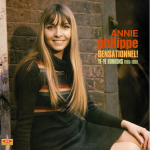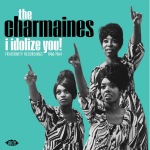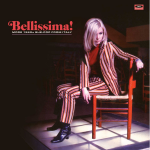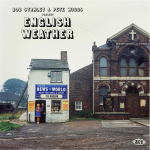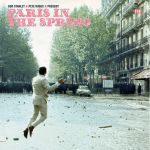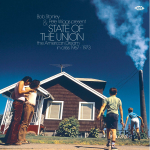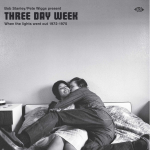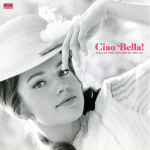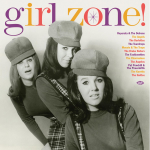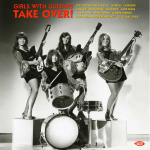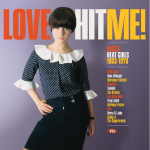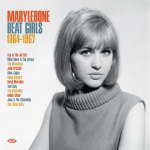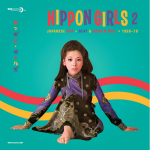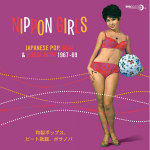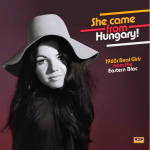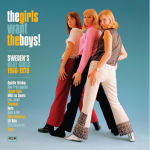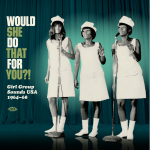Labels
Ace
- 01. C'est La Mode
02. Plus Rien
03. Pour La Gloire
04. Pas De Taxi (EP version)
05. On M'a Toujours Dit
06. Tu Peux Partir Où Tu Voudras (Go Where You Wanna Go)
07. J'ai Tant De Peine
08. Sensationnel Jeffry
09. J'ai Raté Mon Bac
10. Une Petite Croix
11. Le Mannequin
12. Bonjour, Bonsoir Et Au RevoirANNIE PHILIPPE
Sensationnel! Yé-Yé Bonbons 1965-1968
[engl] This release on our occasional Ace International imprint comprises an hour of pure pop highlights from the career of Annie Philippe, one of France’s leading yé-yé girls. The collection is available as a 24-track CD and 12-track 180g red vinyl album, both featuring notes by Jean-Emmanuel Deluxe, author of the recent book Yé-Yé Girls Of 60s French Pop, who interviewed the lovely Annie specifically for this project. Annie was launched into a yé-yé world dominated by Sheila, Sylvie Vartan, Françoise Hardy and France Gall. Her debut, a Lulu cover, didn’t fly for the 17 year-old Parisienne, but sales were excellent for her follow-up, a version of the Supremes’ ‘Baby Love’. A year passed before Annie achieved fame at a parallel level to those others girls; her smash hit ‘Ticket De Quai’ paved the way for many others and remains her biggest seller. Annie’s final chart record came at the end of 1967, following which superstar Claude François signed her to his newly formed label, where she saw out the decade. There were sporadic releases in the ensuing decades but, after a protracted silence, she re-emerged looking as glamorous as ever. “Even with the passing of time, I’m still proud of my catalogue,” says Annie. “I had great lyricists such as Gilles Thibaut and Jacques Revaux, and arrangers like Paul Mauriat, Jean-Claude Vannier and Christian Gaubert. Back in those days budgets were not a problem. I even had Bashung, who composed ‘Une Petite Croix’ with me in mind. I think a really nice and overlooked song in my repertoire is ‘Bonjour, Bonsoir Et Au Revoir’, composed by Le Système Crapoutchik, a Beatles-influenced act who were Jacques Dutronc’s band. I even had the great drummer Daniel Ceccarelli working with me.”- Format
- LP
- Release-Datum
- 24.09.2016
- 01. I Idolize You
02. Rockin' Pneumonia
03. Goodbye Baby Goodbye
04. G.I. Joe (Second version)
05. On The Wagon
06. What Kind Of Girl (Do You Think I Am)
07. Sticks And Stones
08. Money (That's What I Want)
09. Rockin' Old Man
10. Where Is The Boy Tonight
11. All You Gotta Do
12. G.I. Joe (First version)
13. Don't Take Away Your Love
14. Baby Please Don't GoMoney (That's What I Want)CHARMAINES, THE
I Idolize You! Fraternity Recordings 1960-1964
[engl] A vinyl-only 14-track collection of the Cincinnati trio’s best Fraternity recordings. A brief appearance on Billboard magazine’s Bubbling Under chart belies the fact that the Charmaines were Cincinnati’s leading 1960s girl group. Formed by Marian “Gigi” Jackson, Dee Watkins and Irene Vinegar, the group was awarded a contract with Fraternity Records for winning a talent show in 1960. Gigi’s sister Jerri sang on many of the group’s records but was too young to perform in nightclubs. When Dee left to get married, Jerri joined as a full-time member. By the time the Charmaines’ contract with Fraternity had run its course, the group had relocated to Canada. “We’d had a successful career at Fraternity and were quite happy there,” says Gigi. “We had a few little hits with ‘What Kind Of Girl (Do You Think I Am)’, ‘On The Wagon’ and ‘G.I. Joe’ and got lots of work, especially in Canada. We were going back and forth to Toronto so much, doing nightclubs and concerts, that in 1963 the Charmaines actually moved up there. When the British groups first became popular over here, we were living in Canada at that time. I remember the Dave Clark Five and the Rolling Stones coming up to Canada. They were at Maple Leaf Gardens, and at about four of those shows we were the opening act.” The Charmaines called it a day in the early 70s but several of their records remained popular with dancers on the UK’s northern soul scene. That popularity received a boost in the mid-2000s when their great version of Ike & Tina Turner’s ‘I Idolize You’ was made available for the first time, immediately finding favour with DJs and club-goers. During their career the group had singles on six different labels, but they never did have an album released. We rectify that situation here with this stylishly packaged vinyl-only collection of their finest Fraternity recordings. Along with the above-mentioned titles, highlights include ‘Goodbye Baby Goodbye’, the Shirelles-style ‘Where Is The Boy Tonight’, their rip-roaring version of ‘Rockin’ Pneumonia’ and three terrific examples of their work as backing singers for Fraternity label-mates Lonnie Mack and Carl Edmondson. MICK PATRICK- Format
- LP
- Release-Datum
- 15.07.2019
- 01. Marisol - Corazón Contento
02. Rocío Dúrcal - Creo En Ti
03. Karina - Ya Verás
04. Gelu - Pinta Mi Mundo
05. Los Stop - Molino Al Viento
06. Sonia - Aquí En Mi Nube
07. Rosalía -Si Llegara El Amor
08. Adriángela - Nunca Hay Bastante
09. Massiel- No Sé Por Qué
10. Silvana Velasco - Prima O Poi
11. Lorella -Tendrás Que Llorar
12. Soledad Miranda - La Verdad
13.Los Mismos - Voy A Pintar Las Paredes Con Tu Nombre
14. Las Chic - Pon Un Anillo En Mi DedoV/A
Beat Girls Espanol! 1960s She-Pop From Spain
[engl] The feminine side of Spanish pop, including some great 1960s examples of the “Torrelaguna sound”. Having already put out collections spotlighting the girl singers of 1960s Japan, France, Italy and Sweden, we now turn our attention to sunny Spain. The influence of hit records from the USA and the UK in the early 60s resulted in a musical style the French called yé-yé. Spain also adopted the term to describe this new type of beat-oriented pop, while maintaining its own musical identity via sexy rhythms and an underlying current of drama and flamenco. The aptly named Hispavox was considered the most important Spanish record label, mainly because they had a talented team of producers, arrangers and studio musicians who between them created the “Torrelaguna sound”. Furthermore, they had Karina, who was known as the queen of Spanish yé-yé with her angelic looks and voice, and Las Chic, one of the few girl groups on the Spanish recording scene. Zafiro entered the market with a series of young female vocalists, including Adriángela and the dynamic Marisol, a child actress turned pop star who spent much of the 60s on the silver screen. The Belter label also recorded many girl singers, among them screen siren Soledad Miranda – star of several horror films – and Sonia, who recorded a feminine rendition of the Rolling Stones’ ‘Get Off Of My Cloud’. Other noteworthy artists include Rocío Dúrcal, who achieved international fame as an actress and a singer, Gelu, who rather specialised in covering Petula Clark hits, and Massiel, who differed from most of her peers by writing many of her own songs. All of these and more are featured here in this compilation of predominantly uptempo recordings by the choicest female artists active in 1960sSpain. The collection is available in 14-track LP and 24-track CD formats. The LP version is pressed on 180g white vinyl and packaged in a heavy-duty sleeve with an inner bag featuring a 3500-word note and copious colour illustrations. The CD edition comes with a bumper 24-page booklet containing expanded notes and extra illustrations.- Format
- LP
- Release-Datum
- 26.01.2018
- EAN
- EAN 029667007115
- 01. Orietta Berti - Le Ragazze Semplici
02. Mina - Cartoline
03. Caterina Caselli - Il Volto della Vita
04. Patty Pravo - Il Paradiso
05. Gigliola Cinquetti - Zero In Amore
06. Lisa Gastoni - Una Stanza Vuota
07. Milva - Tamburino, ciao
08. Meri Marabini - E' Proprio Inutile
09. La Ragazza 77 - Il Beat...Cos'è?
10. Ornella Vanoni - Il Coccodrillo
11. Catherine Spaak - Se Mi Vuoi, Mi Vuoi
12. Rita Pavone - Il Treno
13. Vibeke - A Me Piace Lui
14. Iva Zanicchi - Come Ti VorreiV/A
Bellissima! 1960s She-Pop From Italy
[engl] Comprising soaring big beat ballads, the occasional guitar-driven nugget and other feminine pop gems of the stylish Italian variety, this much-anticipated follow-up to “Ciao Bella!” (one of Ace Records’ best sellers of 2015) offers further proof that there is musical life beyond the shores of English-speaking countries. “Bellissima! More 1960s She-Pop From Italy” comprises an equal mix of superstars and obscure artists, performing songs of both Italian and overseas origin. Living legend Mina sings ‘Cartoline’, one of several numbers custom-composed by maestro Bruno Canfora to show off her fantastic vocal technique, and her arch rival Milva delivers the stomping ‘Tamburino, Ciao…’, another top-tier Italian original, while highlights of the selections by lesser-known vocalists include ‘È Proprio Inutile’ by Meri Marabini and ‘Il Beat... Cos’è?’ by La Ragazza 77, groovy covers of the Hollies’ ‘You Know He Did’ and Sonny & Cher’s ‘The Beat Goes On’ respectively.- Format
- LP
- Release-Datum
- 15.07.2019
- EAN
- EAN 029667008310
- 01. Love Song With Flute - Caravan
02. Moon Bird - The Roger Webb Sound
03. Early Morning Eyes - The Parlour Band
04. Pamela - Scotch Mist
05. The Prisoner (Eight By Ten) - Spring
06. Last Cloud Home - The Orange Bicycle
07. JLT - T2
08. Til The Christ Come Back - Bill Fay
09. Refugees - Van Der Graaf Generator
10. Very Nice Of You To Call - Aardvark
11. Big White Cloud - John Cale
12. Bottles - Belle Gonzalez
13. Watching White Stars - The Way We Live
14. Windfall - Offspring
15. Never Let Go - Camel
16. Wise Man In Your Heart - Daevid Allen
17. O Caroline - Matching Mole
18. Edge Of The Sea - Prelude
19. Evening Shade - Alan Parker and Alan Hawkshaw
V/A
Bob Stanley & Pete Wiggs Present English Weather
[engl] The autumnal sound of Britain at the turn of the 70s, looking out through wet window panes to a new decade with a mixture of melancholy and optimism for what might come next. With the Beatles gone and the pound sinking, a new and distinctive sound emerges, led by flutes and mellotrons. Available in 18-track CD and 19-track double LP formats. The LP version is pressed on 180g vinyl in heavy-duty gatefold sleeve. It’s hard for me – and I’m guessing I’m not alone here – to shake the Get Carter theme from my head whenever I cross the Tyne rail bridge on a journey up from London. The city may have changed dramatically since the film was shot at the turn of the 70s, but the weather hasn’t. One day last autumn I was working in Newcastle. With an afternoon to kill, I did what I usually do with a couple of spare hours in an unfamiliar town – I sought out a record shop. It would at least protect me from the rain, which was getting steadily heavier. As I flicked through the racks I was trying to identify the record that was playing, an album with a hint of Crosby, Stills and Nash but an identifiably British pall hanging over the sunny harmonies. It was by Shape Of The Rain, and had a sepia sleeve which was an attempt to suggest the Old West even though it was clearly a shot of a post-industrial Britain that still felt closer to the War than it did to punk, just six or seven years down the line. Outside the Newcastle rain was getting ridiculous. I was stuck in the shop. There was no one in there apart from me and Craig, the lad behind the counter. Once he’d twigged that I was genuinely interested in the Shape Of The Rain LP he pulled out T2’s “It’ll All Work Out In Boomland” and stuck it on the Hacker turntable. The sound was warm but slightly awkward, slashing guitars that recalled 1966 and frenetic drums hemmed in by warm brass, minor chords, and the kind of hazy nonchalant English vocals reminiscent of Caravan, or More-era Pink Floyd; not an easy listen, but absorbing. Then he revealed albums by the Parlour Band, Aardvark and Spring. All of them were melodic, melancholy, with jazz and folk touches and the same similar shrug of resignation, their collars turned to the wind of 1970 and the end of the Aquarian dream. Enveloped in this post-psychedelic cocoon, sheltering from the rain, these records made a lot of sense together. I had childhood flashbacks of cafés with steamed-up windows, occupied by workmen in donkey jackets; hippies and bikers on Box Hill; odd music on Radio 1 on a Sunday afternoon that had a sense of serious intent but without knowing what for. While America may have licked its wounds at the turn of the 70s by turning to singer-songwriters, purveyors of homilies like “teach your children well”, Britain wasn’t so ready to give up the trappings of psychedelia. And while the UK counter culture may have shed its “faith in something bigger”, it wasn’t about to chuck out the mellotron. This is how the day after the 60s felt: damp, fuzzy-headed, neither optimistic nor pessimistic but more than a little lost. British bands would mirror the ennui of the new decade with a new kind of music. Any song on this collection could have been on the soundtrack of Bronco Bullfrog, Barney Platts-Mills’ film about bored youth trying to get its kicks in crumbling 1969 East London; each of them could have been the title song for the same director’s Private Road, with its young couple holed up in a country cottage, directionless, travelling without a destination. The post-psychedelic, pre-progressive age was brief, but rarely has contemporary music summed up a sense of place and time so perfectly. Some of these songs pre-date and post-date this era but all of them share an atmosphere. Plenty of the acts on this compilation only got to make one album. Some got to make many more, but even with the bands who became leviathans of progressive rock, their debuts tended to be more focused, more human-sized; significantly, they pre-dated the term, and therefore the connotations of “prog”. English Weather was also the name of a record shop I loved when I first moved toLondon, out in Crouch End which, back in the mid-80s, was deep bedsitter land. The shop was run by Dark Star magazine’s Steve Burgess – a major influence on my tastes and my writing, Steve put me onto records such as Mellow Candle’s “Swaddling Songs”, Fairfield Parlour’s “From Home To Home” and the now-venerated Spring album: “It may look like prog”, he said of Spring, sensing my scepticism at the peak of prog’s unfashionability, “but it's beautiful”. He was right. I hope he’d have liked this selection.- Format
- DoLP
- Release-Datum
- 24.01.2017
- EAN
- EAN 029667005517
- 01. La Victime (Part 1) - Karl Heinz Schäfer
02. Hélicoptère - Mireille Darc
03. Les Aventures Extraordinaires D'Un Billet De Banque - Bernard Lavilliers
04. Roses And Revolvers - Janko Nilovic
05. L'Élu - Ilous & Decuyper
06. La Métaphore - Jacques Dutronc
07. Dommage Que Tu Sois Mort - Brigitte Fontaine
08. Les Gardes Volent Au Secours Du Roi (Alternate version) - Jean-Claude Vannier
09. Looking For You - Nino Ferrer
10. Chanson D'Un Jour D'Hiver - Cortex
11. Viens - Françoise Hardy
12. Couleurs - Léonie
13. Leslie Simone - William Sheller
14. Litanies - Triangle
15. Baleines - François De Roubaix
16. Encore Lui - Jane Birkin
17. Evelyne - Serge Gainsbourg
18. Lilith - Léonie
19. Ystor - Ys
20. Chanson Pour Que Tu M'Aimes Un Peu - France Gall
21. La Victime (Part 2) - Karl Heinz Schäfer
22. La Chanson D'Hélène - Romy Schneider & Michel PiccoliV/A
Bob Stanley & Pete Wiggs Present Paris In The Spring
[engl] In May 1968, Paris was burning. Out of the student uprising came a new wave in French music that matched the country’s mood – darker, and more introspective than yé-yé, France’s cultural revolution allowed the previously separate worlds of chanson, jazz, pop and film soundtracks to blend into each other. Laden with strings and sample-ready rhythm tracks, this new sound was exemplified by Serge Gainsbourg’s “Histoire De Melody Nelson”, but it wasn’t an isolated classic – this was a golden age for French pop. Amid the student demonstrations and riots that stretched from Chicago to Grosvenor Square in 1968, France came the closest of all western countries to a genuine revolution. The Sorbonne was occupied. There was a general strike. The government planned to station tanks at Issy-Les-Moulineaux on the south side of Paris. President De Gaulle fled the country, hiding in Germany’s French embassy. The uprising may have superficially concluded with nothing more dramatic than fresh elections, and an ongoing conservative government, but the events of that May are seen as a turning point in the country’s social history – pictures of the barricades are still potent images. Lines were drawn politically, culturally, socially – pop music, naturally, was not exempt. The music that emerged from France between 1968 and the mid-70s was an extraordinary blend of several previously independent strains – French chanson and yé-yé, American jazz and funk, British chamber pop – shot through with the era’s underlying mixture of optimism and darkness. Prior to 1968, French pop had been dominated by yé-yé, the country’s unique brand of upbeat pop whose most famous names were the photogenic couple Johnny Hallyday and Sylvie Vartan – it was a world of primary colours, mini jupes and discothèques (a French invention, after all), which appeared not on singles but beautifully packaged EPs. One of yé-yé’s biggest stars, and the only one to have commercial success in the UK, was Françoise Hardy: “We, the singers, were far, far fewer in number than today, and there were fewer radio stations. It was also the heyday of [monthly pop magazine] Salut Les Copains, and the press played an extremely important role – it could promote beginners. However, we were not very popular with the previous generation, or with some journalists, who wanted to pinch us over our ignorance. We often came from relatively poor working class backgrounds, while the next wave of Alain Souchon, Véronique Sanson, Michel Berger, Julien Clerc came from the bourgeoisie. I felt oddly legitimised in the early 1970s.” If yé-yé was all about the noise of teenage life, then traditional French chanson was all about the words, which the French took very seriously (Dylan meant a lot more in France than the Beatles or the Stones). Poetry and the lyrics of chansons were sacrosanct, and would never have been tainted by what was regarded as the basic silliness of pop. Before 1968 you wouldn’t include serious lyrics in a song unless you were a chanson heavyweight like Charles Aznavour, Jacques Brel, Georges Brassens, Léo Ferré or Barbara. The differences were largely generational; the worlds of jazz, chanson and pop rarely trod on each other’s toes. By 1970, though, Léo Ferré was working with a rock group on a concept album about anarchy and sexual liberation. This bleed between genres was unthinkable before 1968. Serge Gainsbourg – a jazz pianist with a chanson past and a pop present – was in a position to play a key role in soundtracking France in flux over the next five years. The seriousness and observation in French chanson leaked into pop almost as soon as the student uprising and the ensuing strikes that paralysed the country began. The uprising coincided with a major change in the French record industry. Prior to 1968, almost all French music was released on four-track EPs, and albums simply gathered tracks from these EPs. The album market as we know it didn’t exist in France before 1968. Given the chance to stretch out on a full-length album, and given the political climate, musicians quickly began to think in terms of song cycles. Was there anything in French pop prior to May ’68 to suggest the imminent sea change? 1966 had seen the rise of the beatnik Michel Polnareff; the sardonic, impeccably groomed Jacques Dutronc; and the Dylan-channelling student protest singers Stella and Antoine, who had a running spat with Johnny Hallyday and ended up on the receiving end of Hallyday’s 1966 hit ‘Cheveux Longs Idées Courtes’. A year on, Dutronc was ridiculing flower power on the terrific ‘Hippie Hippie Hourrah’ while Gainsbourg, a songwriter who had always been the salt in the caramel of yé-yé, went a step further on France Gall’s ‘Teenie Weenie Boppie’: “What are these flowers with exquisite colours that drift with the current? It’s Mick Jagger in the Thames, drowned in his fine clothes.” What yé-yé had tended to avoid – with gentle exceptions like Antoine, Polnareff and Stella – was the growing underground of disillusioned youth, but clearly there was discontent fomenting. It made sense that the more adventurous acts working in French pop would want to expand their musical palette in the new era, moving closer to both the literary bent of chanson and the progressive and psychedelic sounds of Anglo-American rock. The album was seized upon as a means of expression for already established acts; the result was such era-defining records as Michel Polnareff’s “Polnareff’s”, Françoise Hardy’s “La Question” and Serge Gainsbourg’s “Histoire De Melody Nelson”. The unsettled national mood also dictated more darkly accented music for films and TV. The result was a hipper background noise, free of accordions, which skilled practitioners like Gainsbourg, his arrangers Alain Goraguer and Jean-Claude Vannier, and jazz musicians like Karl Heinz Schäfer and Janko Nilovic were more than happy to produce. Film director Jacques Poitrenaud has talked about “the arrival in 1968 of a new generation of composers, represented by [Jean-Claude] Vannier. His writing was scholarly, unusual, and influenced by pop.” Typically these writers used a feline rhythmic groove, a hovering Hammond organ, unsettling fuzz guitar, and a full string section to carry their radiant melodies. Without a doubt, after May ’68 it was fashionable and desirable to be seen as left-wing. Not everyone was on board. Some yé-yé stars, like Johnny Hallyday, were quite keen to distance themselves from the state of near-revolution. Others abandoned music altogether: Hugues Aufray, the folk singer who had introduced Dylan to France with his cover versions and sang for Martin Luther King, went into retirement and didn’t re-emerge until 1972; Antoine, erstwhile king of protest, recorded the disillusioned ‘Ramenez-Moi Chez Moi’ (Take Me Home), then gave up singing to sail around the world. With so much going on, and so many new possibilities for French music, they weren’t really missed.- Format
- DoLP
- Release-Datum
- 24.05.2018
- EAN
- EAN 0 29667 00811 2
- 01. Elvis Presley with The Blossoms Clean - Up Your Own Back Yard
02. Della Reese - Brand New Day
03. Dion - Abraham, Martin And John
04. Frank Sinatra - The Train
05. The 4 Seasons - Saturday's Father
06. The Beach Boys - 4th Of July
07. Anita Kerr & The Anita Kerr Singers - Wine In The Wind
08. Bing Crosby - What Do We Do With The World?
09. The Everly Brothers - Lord Of The Manor
10. The Four Preps - Hitchhiker
11. Lou Christie - Paint America Love
12. Ray Stevens - Mr. Businessman
13. Eartha Kitt - Paint Me Black Angels
14. Roy Orbison - Southbound Jericho Parkway
15. Bobby Darin - Questions
16. Paul Anka - This Crazy World
17. Mel Torme - Take A Letter Maria
18. Louis Armstrong And His Friends - Give Peace A Chance
19. Eugene McDaniels - Cherrystones
20. The Tokens - Some People Sleep
21. Buddy Greco - Cardboard California
22. Dean Martin - Do You Believe This Town?
23. Johnny Tillotson - Welfare Hero
24. Teresa Brewer - Save The Children
25. The Brothers Four - RevolutionV/A
Bob Stanley & Pete Wiggs Present State Of The Union - The American Dream In Crisis
[engl] The sound of a country trying to work its way out of a crisis. By 1968 there was a growing consensus that something had gone horribly wrong with the American dream. With urban riots, Vietnam, the assassinations of Martin Luther King and Bobby Kennedy, and ever-climbing divorce rates, the American way of life was under scrutiny from all sides. The nation’s youth had loudly made their feelings clear, but now the older, pre-Beatles generations began to look at the country and wonder what the hell was happening. This album includes rare classics (the Beach Boys’ ‘4th Of July’), lost masterpieces (Roy Orbison’s seven-minute ‘Southbound Jericho Parkway’) and forgotten gems by some of the biggest names in the business (Elvis Presley’s ‘Clean Up Your Own Back Yard’). Reactions to America’s existential crisis ranged in subject matter from divorce (Frank Sinatra’s ‘The Train’) and the break-up of the nuclear family (the Four Seasons’ ‘Saturday’s Father’, Mel Tormé’s ‘Take A Letter Maria’), to eulogies for fallen heroes (Dion’s ‘Abraham Martin And John’), sympathy for Vietnam vets (Johnny Tillotson’s ‘Welfare Hero’), the church’s institutional racism (Eartha Kitt’s intense ‘Paint Me Black Angels’), the hypocrisy of establishment figures (Dean Martin’s ‘Do You Believe This Town’) and even questioning the ethics of the space programme (Bing Crosby’s terrific ‘What Do We Do With The World?’). It is now shocking to read that, as recently as 1968, the Bureau of Land Management proposed to build dams in the Grand Canyon; Richard Nixon would sign an executive order setting up the Environmental Protection Agency in December 1970. His administration then commissioned the Documerica photography project, which launched in 1971 – the year Marvin Gaye sang about “fish full of mercury” in a Top 10 hit – and it showed, shockingly, how the American way of life was trashing the landscape and poisoning the population. It provides the artwork for this album, a condensation of what America’s older generation were thinking when they turned on the TV, or the radio, or simply walked down Main Street in 1968. BOB STANLEY- Format
- DoLP
- Release-Datum
- 24.10.2018
- EAN
- EAN 029667008716
- 01. The Brothers - Part Of The Union
02. Small Wonder - Ordinary Boy
03. Ricky Wilde - The Hertfordshire Rock
04. The Kinks - When Work Is Over
05. The Sutherland Bros Band - Sailing
06. Adam Faith - In Your Life
07. Phil Cordell - Londonderry
08. Stud Leather - Cut Loose
09. The Troggs - I'm On Fire
10. Mike McGear - Kill
11. Lieutenant Pigeon - And The Fun Goes On
12. Mungo Jerry - Open Up
13. Matchbox - Rod
14. Marty Wilde - She's A Mover
15. Hawkwind - Urban Guerrilla
16. Edgar Broughton Band - Homes Fit For Heroes
17. Bombadil - Breathless
18. Robin Goodfellow - Why Am I Waiting
19. Cockney Rebel - What Ruthy Said
20. Paul Brett - Clocks
21. The Troll Brothers - You Turn Me On
22. Climax Chicago - Mole On The Dole
23. Barracuda - I Feel So Down
24. Wigan's Ovation - Northern Soul Dancer
25. Stavely Makepeace - Don't Ride A Paula Pillion
26. Pheon Bear - War Against War
27. Roly - Roly Pin
28. David Essex - StardustV/A
Bob Stanley & Pete Wiggs Present Three Day Week - When The Lights Went Out 1972-1975
[engl] Britain wasn’t on its own in having a thoroughly miserable 1973: O Lucky Man! and Badlands both found a great year to premiere; Watergate brought America to a new low. But America didn’t still have back-to-backs and outside bogs. Tens of thousands of Britons were still housed in wartime pre-fabs. The bright new colours of the post-war Festival of Britain and Harold Wilson's talk in the 60s of the “white heat of technology” now seemed very distant as strikes, inflation, and food and oil shortages laid Britain low. What had gone wrong? And what did pop music have to say about it? Many of the year’s biggest acts had set out on their particular journeys in the most idealistic years of the 60s (Yes, Genesis, the Moody Blues) and still held traces of that era’s promise. For acts such as Bowie and Roxy Music who had emerged in the new decade, one way out of the British malaise was to look into the future, embracing modernism and the space age beyond, a world of electric boots and mohair suits. Another was to draw heavily on the revered 50s, retreating to rock’s unsullied roots while remaining ostensibly current – Wizzard, Mott The Hoople and even the Rubettes managed to reshape the 50s to their own ends, much as Springsteen did in the States, although beyond them lay Showaddywaddy, Shakin’ Stevens, and a sickly nosedive into nostalgic yearning. This left a small rump of acts diligently soundtracking Britain’s present, not with a wagging finger but a fuzzy guitar, a primitive synthesiser, and a pitch-black sense of humour. Quite often these records were cut in home studios – many featured the same basic synth (just the one) that Roxy’s Eno and Hawkwind’s DikMik used; the guitarists still played blues progressions picked up from the Stones; and they sometimes touched on glam – the era’s brightest, newest noise – found inspiration in its disposability and its energy, but didn’t have the luxury of a Chinn and Chapman or a Mickie Most to sprinkle fairy dust on their final mix. And outside the studio door were the strikes, the cuts, economic chaos, teenage wasteland – these musicians created music that, intentionally or not, echoed their surroundings. It wasn’t glam, but it emerged from what Robin Carmody has called “the glamour of defeat, the glory of obliteration”. The songs on “Three Day Week” amplified the noise of a country still unable to forget the war, even as it watched the progressive post-war consensus disintegrating. We hear shrugs and cynicism, laughter through gritted teeth. Comparing it to the richness of records made just five or six years earlier, you might think musical instruments had been rationed, and that everyone has one eye on the clock, cutting corners to get the recording finished before the next power cut. You picture engineers in donkey jackets, with a brazier by the mixing desk. You hear odd electronic explosions, quacks and squiggles. The pub piano is predominant, with its brown ale, Blitz-spirit, grin-and-bear-it jollity. And under many of these tracks is a barely concealed frustration (sexualised on the Troggs’ ‘I’m On Fire’) and even anger (how else to read ‘Urban Guerrilla’, or the howling and the hand grenade at the end of Stud Leather’s ‘Cut Loose’?). Think of “Three Day Week” as an extended, musical Play For Today. The Three Day Week itself – which only lasted eight weeks, but was the nadir of a four-year-long depression – had been a result of the Tory government’s limit on pay rises in October 1973 and the miners strike that followed. Back at the start of 1972 the miners had struck for higher pay and won, averting Prime Minister Edward Heath’s threat to introduce a three day week in manufacturing and industry to hold on to energy reserves. By late 1973, though, the miners had slipped from top of the industrial wages league to 18th. Amid strikes by civil servants, medical staff, railway and dock workers, the miners went on strike again. The Three Day Week proper lasted from New Year’s Day to 7 March 1974. TV shut down at 10:30. Power cuts and blackouts in homes across Britain meant the sales of candles and torches soared. Old soldiers tutted. The Army were on standby. And, nine months later, there was a spike in the birth rate. For the younger generation, however, the Three Day Week is not remembered as a period of woe. Power cuts were fun! Who wouldn’t like the idea of a three day week? More time to play! It was also easy for kids to confuse pop culture and politics when the Prime Minister was Ted Heath and the leader of Britain’s biggest union, the TGWU, was Jack Jones. Even the TUC’s leader Vic Feather sounded like the bassist from a RAK act. There is also the folk memory of the period being a high-water mark for the power of trade unions, who seemingly always struck for higher pay and won, a dreamtime for many on the left. The second miners strike brought down the Tory government – what a time to be alive! Margaret Thatcher was only education secretary at this point, the hated “milk snatcher”, and no one had a crystal ball to see what the Tory reaction might be several years down the line. The records on this collection were almost all released as 45s, sent to shops in cost-cutting plain white paper bags, and – thanks to the oil shortage caused by the Arab-Israeli conflict – pressed on thinner vinyl than you’d have had ten years earlier. On every level, they felt as if they were being recorded and released under wartime restrictions. Many of these tracks were B-sides, recorded in haste, with no commercial forethought or relevance to the A-side, because, as Peter Shelley recalls, “You’d made the wild assumption that no one would ever play it”. Why did the music end up sounding this way? There had been a general sense of decline in Britain since the turn of the decade – not only in industry but in film, art, fashion, and in people’s expectations. You could trace its roots further back to 1968, when the collapse of the Ronan Point tower block in East London sounded a death knell for modernist dreams. Or to 1967, a year for which Swinging London has prevailed in popular memory over Cathy Come Home, but which should be remembered for the devaluation of the pound and the capital's nationalistic dock strikes as much as Alexandra Palace’s 14 Hour Technicolour Dream. By 1972, everything new – be it a brick wall or a terylene suit – was a shade of brown or orange, and the smell of sweat and odour-hugging man-made fabrics (not only clothes but carpets and curtains) was dominant. The worsted mills of Bradford and cotton mills of Manchester were fast disappearing, and the mix of wet wool, chimney smoke and boiled cabbage that Shena Mackay recalled being London’s olfactory default in the 60s had been replaced by weeks-old fag smoke, BO, and something plasticky you couldn’t put your finger on. Few of the songs on “Three Day Week” are politically direct: the Edgar Broughton Band had been Ladbroke Grove rabble rousers at the tail end of the 60s, but their ambitions sound entirely blunted on the monochrome hopelessness of ‘Homes Fit For Heroes’; Phil Cordell’s ‘Londonderry’ is diffuse, but it was an odd place to single out for a song title in 1973; Pheon Bear appears to be losing the will to live even as he shouts himself hoarse on ‘War Against War’. The ambivalence of the Strawbs on ‘Part Of The Union’ – a #2 hit – is entirely in keeping with the pub humour and shrugging cynicism of the era. So there is a little agitation here, but there is plenty of gleeful irreverence. One more drink? What have we got to lose? The government’s on its knees and we might all be out of work tomorrow. Quick, somebody, get on the piano before the lights go out again. BOB STANLEY- Format
- DoLP
- Release-Datum
- 29.03.2019
- EAN
- EAN 029667009317
- 01. Brunetta E I Suoi Balubas - Baluba Shake
02. Mina - No
03. Ornella Vanoni - Il Mio Posto Qual'è
04. Caterina Caselli Con Gli Amici - Sono Qui Con Voi
05. Isabella Iannetti - Un Amore Inutile
06. Catherine Spaak - La Notte È Fatta Per Rubare
07. Rita Pavone - Il Geghegè
08. Carmen Villani - Questa Sinfonia
09. Patty Pravo - Ragazzo Triste
10. Rita Monico - Non È Mai Tardi
11. Mina - Se Telefondo
12. Nada - Pà Diglielo A MàV/A
Ciao Bella! Italian Girl Singers Of The 60s
[engl] Connoisseurs of 1960s girl-pop have been well served in the CD era, particularly those with a preference for American or British singers. Good music, of course, is not exclusive to the English-speaking world, and collections devoted to the female vocalists of France, Japan, Spain and Germany are also available, but to the best of my knowledge their Italian counterparts have not been anthologised. If “Ciao Bella!”, released as a 24-track CD and a 12-track 180g white vinyl LP in gatefold sleeve, is the first of its kind, let’s hope it’s not the last. In a country known for its song festivals, most notably the prestigious event held annually in Sanremo, lushly orchestrated ballads have always been especially popular, and a few exceptional examples are featured here. We open, however, with a selection of uptempo titles. The CD version begins with Brunetta’s prized dancefloor-filler ‘Baluba Shake’ and closes with ‘Cuore’, a dramatic beat ballad by freckle-faced firebrand Rita Pavone. Star of the show is the prolific Mina, queen bee of Italy’s female singers, with three tracks: ‘No’, a jangly folk rock nugget; ‘Più Di Te’, a cover of the Tracy Dey/Bob Crewe classic ‘I Won’t Tell’; and ‘Se Telefonando’, a sophisto-pop opus courtesy of maestro Ennio Morricone. Other highlights include the sitar-embellished ‘Il Mio Posto Qual’è’ by Ornella Vanoni, a convincing cover of ‘Baby Please Don’t Go’ by beat girl Caterina Caselli, Gigliola Cinquetti’s superbly orchestrated Eurovision-winner ‘Non Ho L’età (Per Amarti)’ and breathy-voiced actress Catherine Spaak’s bossa-flavoured ‘La Notte È Fatta Per Rubare’.- Format
- LP
- Release-Datum
- 25.03.2015
- 01. Reparata And The Delrons - Panic
02. The Angels - Louie Louie
03. The Darlettes - Here She Comes
04. The Teardrops - Here Comes Loneliness
05. Mousie & The Traps - It's All In The Way (You Look At It Baby)
06. The Drake Sisters - Smoke From Your Cigarette
07. The Fashionettes - Losin' Control
08. The Charmaines - I Idolize You
09. The Angelos - Backfield In Motion
10. Pat Powdrill & The Powerdrills - Together Forever
11. The Kavetts - I've Got A Story To Tell You
12. The Ikettes - Camel Walk
V/A
Girl Zone!
[engl] To bridge the gap until the next volume of our long-running “Where The Girls Are” series is ready to roll, we’re releasing this vinyl-only compilation of cherry-picked girl group treasures to keep genre zealots at bay. The collection kicks of with Reparata & the Delrons’ storming ‘Panic’ – too “out there” for mass consumption in 1968, it seems – and closes with ‘Camel Walk’ by Tina Turner’s foxy back-up girls the Ikettes, a dancefloor fave on London’s alt-cabaret circuit. Other highlights include first-time reissues of the Angels’ unlikely stab at frat rock staple ‘Louie Louie’, a lush Gold Star-cut rendition of the Mellows’ doo wop classic ‘Smoke From Your Cigarette’ by identical triplets the Drake Sisters and ‘It’s All In The Way (You Look At It Baby)’ by Mousie & the Traps, a trio of Eva Longoria lookalikes from Chicago. Housed in a heavy-duty sleeve sporting an ultra-rare shot of the Drake Sisters, the album is pressed on 180g lava red vinyl and comes with printed inner bag featuring a 2500-word track commentary and some terrific photos. In other words, it’s not just great to listen to but a good read and gorgeous to look at too. / Mick Patrick- Format
- LP
- Release-Datum
- 25.03.2015
- EAN
- EAN 029667003919
- 01. Girls Take Over - Hi Heel Sneakers
02. The Clingers - Gonna Have A Good Time
03. The Plommons - Last Train To Liverpool
04. The Wrongh Black Bag - Wake Me, Shake Me
05. The Debutantes - Little Latin Lupe Lu
06. Kathy Lynn & The Playboys - I Got A Guy
07. Karen Verros - You Just Gotta Know My Mind
08. The Chymes - He's Not There Anymore
09. The Delmonas - Lies
10. The Tomboys - I'd Rather Fight Than Switch
11. The Lady-Bugs - How Do You Do It
12. The Hairem - Like a SnakeV/A
Girls With Guitars Take Over
[engl] A deluxe vinyl-only collection of guitar-wielding all-girl bands, drop-dead female frat rock and axe-centric she-pop. Pressed on 180g tomato red vinyl in heavy-duty sleeve, with a swanky inner bag sporting a fact-filled 3500-word track commentary and an array of rare photos. Pride of place on this gorgeous to behold release goes to a bevy of gen-u-ine all-gal combos. The eye-grabbing front cover features a great shot of Girls Take Over – sisters Cindy, Rinie and Wendy Wilhelmi and their pal Geri Gibson – who open the show with their one and only single, a fabulously raw and pounding rendition of Tommy Tucker’s ‘Hi Heel Sneakers’, recorded in “some guy’s attic” in Milwaukee circa 1969. The group She also released a sole 45, yet amassed sufficient shelved recordings to eventually fill an entire CD, including the ominous ‘Like A Snake’, an early effort taped when they were still known as the Hairem. Mormon sister band the Clingers, on the other hand, boast a sizeable discography, the gem of which is their Kim Fowley-produced version of the Easybeats’ ‘Gonna Have A Good Time’. Genre faves the Debutantes of Detroit also knocked out a few 45s, of which their version of frat rock staple ‘Little Latin Lupe Lu’ is a highlight. From much further afield –Sweden, in fact – the Plommons feature with their latter-day cult favourite ‘Last Train To Liverpool’. Completing the collection are the jangly ‘He’s Not There Anymore’ by the teenage Chymes from the suburbs of Los Angeles; Karen Verros’ much-prized freakbeat bauble ‘You Just Gotta Know My Mind’; Kathy Lynn & the Playboys’ self-penned rocker ‘I Got A Guy’; a version of Gerry & the Pacemakers’ ‘How Do You Do It’ by the short-lived Lady-Bugs, alias the Murmaids with Jackie DeShannon helping out on lead vocals; the Delmonas’ Milkshakes-backed update of the Knickerbockers’ ‘Lies’; a version of the Blues Project’s ‘Wake Me, Shake Me’ by the Wrongh Black Bag, a band fronted by the young Christine Ohlman of later Saturday Night Live fame; and the cod-Merseybeat ‘I’d Rather Fight Than Switch’ by the Tomboys, a one-off studio group led by beloved session singer Jean Thomas.- Format
- LP
- Release-Datum
- 28.07.2017
- 01. Billie Davis - I'm In Love With You
02. Dana Gillespie - No! No! No!
03. Marianne Faithfull - That's Right Baby
04. Beverley - Where The Good Times Are
05. Twinkle - Poor Old Johnny
06. The Orchids - Love Hit Me
07. The Satin Bells - I Stand Accused (Of Loving You)
08. Truly Smith - I Wanna Go Back There Again
09. Adrienne Poster - Something Beautiful
10. Lulu - I'll Come Running Over
11. Barry St. John - Hey Boy
12. Goldie & The Gingerbreads - Little BoyV/A
Love Hit Me! Decca Beat Girls 1963-1970
[engl] British girl-pop gems from Decca Records’ matchless 1960s roster. For British girl-pop, 1960s Decca is a goldmine. The label had its A&R hounds sniffing into every nook and cranny of the British Isles, signing up Midlands schoolgirls (the Orchids), London folk club denizens (Dana Gillespie, Beverley), former child actresses (Adrienne Poster, Sandra Barry), Liverpudlian girl groups (the Vernons Girls, the Satin Bells), soulful northerners (Elkie Brooks, Truly Smith) and Scots (Lulu, Barry St John), well-connected Chelsea girls (Louise Cordet, Twinkle, Marianne Faithfull), Merseybeat wannabes (Beryl Marsden), talent show winners (Billie Davis, Babbity Blue, Jean Martin) and even transient Americans (Goldie & the Gingerbreads) – all featured in this gorgeously packaged collection. Decca’s female roster was largely placed in the skilled hands of producers, arrangers and writers such as Mike Leander, Andrew Loog Oldham, Shel Talmy, Charles Blackwell and Tony Meehan, who sourced a steady supply of homemade and American soul, folk-rock, beat and pop. The company’s productions carried a sense of excitement, urgency and frequently an audible adoration for US soul and pop sounds. Visiting US producer Shel Talmy, for example, was headhunted by Dick Rowe, Decca’s head of A&R, precisely because of his studio experience with American surf and R&B acts. “Dick was one of the few people in England who was pro-American, not averse to giving young guys some kind of chance to do something,” said Talmy in Stoned, Andrew Loog Oldham’s autobiography. “Love Hit Me!” is available in 24-track CD and 12-track vinyl album formats. The CD version is packaged with a 20-page booklet featuring many rare colour photos and notes incorporating interviews with Billie Davis, Dana Gillespie, Georgina Oliver of the Orchids and Truly Smith, while the LP comes with a lavishly illustrated inner bag and is pressed on 180g sunshine yellow vinyl. Each format features an entirely different set of illustrations. Beat girl fans, take your pick. Sheila Burgel- Format
- LP
- Release-Datum
- 25.03.2016
- 01. Liza Strike - Dancing Yet
02. Billie Davis - Whatcha' Gonna Do
03. The McKinleys - Sweet And Tender Romance
04. Julie Driscoll - Don't Do It No More
05. Alma Cogan - Love Is A Word
06. Helen Shapiro - Stop And You Will Become Aware
07. Beryl Marsden - Music Talk
08. Toni Daly - Like The Big Man Said
09. The Chantelles - I Want That Boy
10. Andee Silver -The Boy I Used To Know
11. Jean And The Statesides - Mama Didn't Lie
12. The Three Bells - He Doesn't Want YouV/A
Marylebone Beat Girls 1964-1967
[engl] Superior 60s she-pop from UK Parlophone, Columbia and HMV – in CD and deluxe vinyl formats. This follow-up to our recent “Love Hit Me! Decca Beat Girls” and “Scratch My Back! Pye Beat Girls” releases spotlights the female singers who recorded during 1964-1967 for the EMI group of labels, headquartered in Marylebone in the heart of London’s West End. As girl-pop champion Sheila Burgel writes in the package, “Most of the female acts signed by EMI were teenagers completely tuned in to the current pop trends. Scottish duo the McKinleys, R&B club habitué Julie Driscoll, talent show winner Billie Davis and Midlands pub singer Beverley Jones took original material from London’s Tin Pan Alley and American covers and gave them a vigorous kick that made for fabulous 45s. They may not have had quite the polish of their US counterparts, but the rough’n’ready sound of the Marylebone Beat Girl was precisely her appeal.” Among the many highlights are ‘Dancing Yet’, a Dobie Gray-style discotheque number by Liza & the Jet Set; ‘Like The Big Man Said’ by Toni Daly, a cover of Italian star Caterina Caselli’s ‘L’uomo D’oro’ with edgy English lyrics by Peter Callander; Helen Shapiro’s latter-day collectable ‘Stop And You Will Become Aware’; ‘Love Is A Word’ by national treasure Alma Cogan, written and produced by Andrew Loog Oldham, no less; and Billie Davis’ groovy gender-switched update of Chuck Willis’ R&B nugget ‘Whatcha’ Gonna Do’. The collection is available in 12-track LP and 25-track CD formats. Julie Driscoll graces the cover of the LP edition, which is pressed on 180g mandarin coloured vinyl in a heavy duty sleeve, with a 3000-word track commentary and an array of rare photos and memorabilia on the inner bag. The CD version, featuring Billie Davis on the cover, comes with a bumper 28-page booklet featuring a 7000-word note and additional photos.- Format
- LP
- Release-Datum
- 30.06.2017
- 01. Kayoko Ishuu - Bazazz No. 1
02. Reiko Mari - Saike Na Machi
03. Linda Yamamoto - Furi Furi 5
04. Mari Henmi - Daniel Mon Amour
05. Chiyo Okumura - Koi Gurui
06. Emy Jackson & Blue Comets - Namida No Go Go
07. Katsuko Kanai - Mini Mini Girl
08. Akiko Wada - Boy & Girl
09. Kemeko Matsudaira - Watashi Ga Kemeko Yo
10. Akiko Nakamura - Namida No Mori No Monogatari
11. The Peanuts - Tokyo No Hito
12. Kazumi Yasui - Warui KuseV/A
Nippon Girls 2: Japanese Pop, Beat & Rock'n'Roll 1966-1970
[engl] Because I’ve tried and failed to put it better myself, I’d like to begin by quoting my colleague Alec Palao: “There was a time not so long ago when credibility in pop and rock music came only from success within the American or British marketplace. No matter how accomplished they might be, foreign acts and their attendant music scenes were frequently viewed with condescension, and anything not sung in English deemed a novelty. As the development of rock in other countries during its first two decades comes increasingly into focus, such cultural imperialism has been proved wrong time and again. Even when its practitioners were aping American or UK acts, each country added something of its own identity. There were different levels of energy too. The raucous abandon ofIceland’s Thor’s Hammer or the Antipodean beat groups contrasts with the sophisticated pop oozed by a French chanteuse. In 60s Japan, you got both sides of the coin – sometimes even within the same record.” We had an inkling it might prove popular with adventurous listeners with a taste for the unusual, but didn’t really expect it to become one of our top sellers of recent years, yet that’s precisely what happened with “Nippon Girls”. With that in mind, we’ve commissioned international girl-pop authority Sheila Burgel to cook up a second helping. As with the first volume, “Nippon Girls 2” is available in CD and 12-inch coloured vinyl formats. Leaving no stone unturned in her quest for groovy sounds, the LP edition includes compelling tracks by Kayoko Ishuu, Reiko Mari, Mari Henmi, Katsuko Kanai, Akiko Wada, Akiko Nakamura, Kemeko Matsudaira, the Peanuts, Kazumi Yasui and Chiyo Okumura, none of whom featured on the first volume. For the record, that’s Chiyo Okumura on the LP cover and another new girl, Kiyoko Ito, on the CD. The CD’s 20-page booklet and the LP’s fold-out jacket are sumptuously illustrated with rare items from former Tokyo resident Sheila’s collection. Sheila also provides the notes, which expertly guide us through our second expedition into the wild and colourful world of female pop from the land of the rising sun. By Mick Patrick- Format
- LP
- Release-Datum
- 25.03.2014
- EAN
- EAN 029667002318
- 01. Jun Mayuzumi - Black Room
02. Mie Nakao - Sharock No.1
03. Keiko Mari - Tsukikage No Rendezvous
04. J Girls - Kiiro No Sekai
05. Reiko Ohara - Peacock Baby
06. Mieko Hirota - Nagisa No Tenshi
07. Rumi Koyama - Watashi No Inori
08. Nana Kinomi & Leo Beats - Suki Sa Suki Sa Suki Sa
09. Miki Obata - Hatsu Koi No Letter
10. Ryoko Moriyama - Ame Agari No Samba
11. Ayumi Ishida - Taiyou Wa Naite Iru
12. Sayuri Yoshinaga With Schoolmates - Koi No YorokobiV/A
Nippon Girls: Japanese Pop, Beat & Bossa Nova 1967-69
[engl] By popular demand, the series kicks off with “Nippon Girls”, a celebration of the female side of Japan’s 1960s pop scene. The LP comprises a dozen highlights from the CD of the same title issued on our Big Beat International logo a couple of years back, one of our recent top sellers. Compiled by DJ Sheila Burgel, a former Tokyo resident, the “Nippon Girls” CD raised a few eyebrows here at Ace HQ, but girl-pop maven Sheila knew what she was doing. The collection drew rave reviews, becoming something of a left-field hit with the club crowd and young hipster types. Sheila also supplied the fascinating and scholarly liner notes, from which we learn that bikini-clad cover girl Jun Mayuzumi’s ‘Black Room’ “boasts booming bass lines and a dancefloor readiness that’s already caught the ear of freakbeat collectors, while Mie Nakao’s fuzz-rocker ‘Sharock No. 1’ takes ‘Green Onions’ as its template. ‘Tsukikage No Rendezvous’ by Keiko Mari is a tamer affair, with Latin rhythms and cute banter between Mari and her all-male chorus. J Girls were sisters Shinobu and Jun Hazuki. Their ‘Kiiro No Sekai’ was recorded in 1969 but remained under wraps until 1995’s “Cutie Pops Collection”. Reiko Ohara’s ‘Peacock Baby’ was released in 1968 and came in a mouth-watering gatefold sleeve. Mieko Hirota was a music heavyweight, close to Dusty Springfield in the ability to inspire awe with her voice. In the mid-60s, she was paired up with Kyohei Tsutsumi, one of Japan’s greatest pop writer/producers. His love of Anglo-American records is clearly audible on ‘Nagisa No Tenshi’, its backing track not very subtly swiped from ‘Cool Jerk’.” The second side makes for an equally compelling listen. Opener Rumi Koyama was “a go-go dancer for TV show Beat Pops. Her debut single is rather square, but its jazzy flip ‘Watashi No Inori’ is just the right amount of raw and teenage. A year after the Carnabeats hit paydirt with a reading of the Zombies’ ‘I Love You’, re-titled ‘Suki Sa Suki Sa Suki Sa’, Nana Kinomi included the same song on her album “Let’s Go Nana!” with GS band Leo Beats. You can hear half-American, half-Japanese model Miki Obata struggle to hit the high notes on ‘Hatsu Koi No Letter’, but it’s considered a Japanese girl-pop staple. Ryoko Moriyama’s ‘Ame Agari No Samba’ attests to the high quality of Japanese bossa nova – as laidback and atmospheric as the Brazilian originals it emulated. Former figure skater Ayumi Ishida’s ‘Taiyou Wa Naite Iru’ is total melodrama, a whirlwind of harpsichord and strings. The star of over a hundred films, Sayuri Yoshinaga appealed to the Japanese mainstream with her modest image and ability to leave audiences in floods of tears. Her ‘Koi No Yorokobi’ is the perfect Japanese girl-pop primer – dark yet upbeat, with all-girl chorus the Schoolmates chirping in the background.” “Nippon Girls” is highly recommended to girl group fanciers, GS groovers and anyone else with a keen ear for eclectic sounds. The LP version sports a zingy gatefold cover by designer Niall McCormack, who also created the 23-inch square poster found tucked inside.- Format
- LP
- Release-Datum
- 25.03.2013
- 01. Ez Az Utolsó Randevúnk - Éva Nagy
02. Csak Fiataloknak - Márta Bencze
03. Fekete Beat - Sarolta Zalatnay
04. Ha Csak Egy Fokkal Szebb Az Ördögnél - Gabi Fenyvesi
05. Júdás Vagy - Kyri Ambrus
06. Keresem A Szót - Zsuzsa Koncz
07. Zsákutca - Clementina Magay
08. Könyörögni Nem Fogok - Zsuzsa Mátray
09. Keresek Egy Fiút - Mária Wittek
10. Mindig Tanul Az Ember - Beáta Karda
11. Nyílik Még Virág - Marika Késmárky
12. Lassan Múlik Az Idõ - Mária Toldy
13. Hazudik A Drága - Kati Kovács
14. Hétköznapi Szerelem - Teréz HarangozóV/A
She Came From Hungary! 1960s Beat Girls From The Eastern Bloc
[engl] Feisty freakbeat, folk rock, funky pop and more from Hungary’s foremost female recording stars – backed by some of the nation’s leading beat bands. Having unearthed girl-pop delights from France, Sweden, Japan, Italy and Spain in recent years, Ace now turn their attention to the Eastern Bloc with this compilation of female-fronted records from Hungary. Following a relaxation of the rule that all music must adhere to strict socialist values, and with nearly 40% of Hungary’s population aged 20 or under, by the mid-60s the younger generation was looking to the West for entertainment. Via European radio stations they discovered beat music, which would become the musical style of choice for many budding bands and singers. All musical work was still required to abide by the government’s Prohibited, Permitted and Propagated policy, which restricted lyrics and dress codes that were deemed permissive or subversive, while every song recorded (or performed live) had to be approved by the National Centre for Popular Music. Once approved, artists were allowed to record with accompaniment by the National TV & Radio Orchestra, the Stúdió 11 ensemble, or – as is the case with most tracks here – by one of a select few Hungarian beat groups that were authorised to record at the time. The KISZ (Hungarian Young Communist League), noting the burgeoning passion for Western music, decided to promote a Hungarian pop culture – where young people could be steered towards performing songs in the national language and with traditional folk instruments. The Táncdalfesztivál, a televised annual song contest set up in 1966, allowed acts to compete live against each other, and proved very popular with viewers. All of the vocalists featured here competed at the Táncdalfesztivál during its initial four-year run. All Hungarian records were issued on the state-run Qualiton label, often with different acts featured on each side. The most successful artists were afforded picture sleeves for their releases but most were packaged in Qualiton company bags, of which there were scores of exceptionally well-designed variations (see back page for some striking examples). In the mid-60s the company began to prioritise the main girl singers – Sarolta Zalatnay, Kati Kovács and Zsuzsa Koncz – and the groups Illés, Omega and Metro, who between them would dominate the Hungarian music scene for the next few years. Sarolta Zalatnay kicked off her solo career with a hit record that helped land her a scholarship in London. There she discovered blues and soul music, which would shape the sound of later recordings such ‘Fekete Beat’ backed by Metro. Kati Kovács’ organ-drenched ‘Hazudik A Drága’ with the band Olympiais just one of many choice cuts from a career that spans 20 albums. Like Kati, Zsuzsa Koncz appeared on the TV talent show Ki Mit Tud? before releasing records. She fronted the beat combo Illés, who back her on the gorgeous ‘Keresem A Szót’. Other highlights here include ‘Ha Csak Egy Fokkal Szebb Az Ördögnél’ by pocket-sized belter Gabi Fenyvesi, ‘Keresek Egy Fiút’ by Mária Wittek, the first performer to don go-go boots and mini skirt on Hungarian TV, and ‘Ez Az Utolsó Randevúnk’ by Éva Nagy, a veritable freakbeat masterpiece. The collection is available in 24-track CD and 14-track vinyl formats. The CD version comes with a bumper 28-page booklet, and the LP is pressed on 180g transparent red vinyl in an illustrated inner bag – each featuring a picture-packed 7,000-word track commentary by compilers Mick Patrick and Matt Meek.- Format
- LP
- Release-Datum
- 24.09.2018
- 01. Ge Dej Till Tåls (Are You Ready For Love) - Agnetha Fältskog
02. Så Synd Du Måste Gå (It Hurts To Say Goodbye) - Anni-Frid Lyngstad
03. The Girls Want The Boys - Eleanor Bodel
04. Kärlek Finns Det Överallt (Lovers Of The World Unite) - MAK Les Soeurs
05. Good Kind Of Hurt - Lena Junoff
06. Last Train To Liverpool - Plommons
07. Don't - Doris
08. Help Me Break This Habit - Bella & Me
09. Vädret (Music To Watch Girls By) - Mona Wessman
10. Lite För Liten (Little By Little) - Lill-Babs
11. You Really Have Started Something - Britt Bergström
12. Benny Law - PlumsV/A
The Girls Want The Boys! Sweden's Beat Girls 1966-1970
[engl] A smörgåsbord of groovy 60s she-pop. 12-track LP version pressed on 180g white vinyl in heavy duty sleeve with sumptuously illustrated artist profiles on inner bag. The Ace Records A&R team has never shied away from venturing worldwide in their quest for good music, as evident most recently from our series of releases spotlighting the female vocalists of 1960s Japan, France and Italy. Now it’s the turn of Sweden. Strange as it might seem, there was a time in the early 1960s when Sweden was not yet a force in pop music. True, there was jazz – Alice Babs, famously, sang with Duke Ellington, and Monica Zetterlund with Bill Evans – and the Spotnicks, an instrumental group who topped the Australian charts and enjoyed minor hits in the UK. And there was Siw Malmkvist! Between 1960 and 1969 she notched up 20 hits in Germany, one of them, ‘Liebeskummer Lohnt Sich Nicht’, sitting at the top of the charts for 12 weeks in 1964. Also that year, in tandem with Umberto Marcato, and singing in Italian, she became the first Swedish vocalist to chart in the US, when ‘Sole, Sole, Sole’ reached the Hot 100. As ‘Sole, Sole, Sole’ and the German connection indicate, pop music in Sweden, at least before the advent of rock’n’roll and Beatlemania, drew largely on the schlager tradition, sprinkled with a canzone or two via the Italian San Remo festival. (Benny Andersson, when awarded an honorary doctorate in 2008, cited Caterina Valente, Mantovani and schlagers as his biggest influences; no doubt, he could have spoken for many Swedes.) “The Girls Want The Boys!” opens with early solo tracks by the lead singers of the country’s greatest pop music export: Agnetha Fältskog with ‘Ge Dej Till Tåls’, a peppy number first recorded by Gloria Hunniford; and Anni-Frid Lyngstad’s recording of the Euro-chic ‘Så Synd Du Måste Gå’, a song popularised by Françoise Hardy as ‘Comment Te Dire Adieu’. Other well-known names include national treasure Lill-Babs with her version of Dusty Springfield’s ‘Little By Little’ and chart star Mona Wessman’s cover of bachelor pad classic ‘Music To Watch Girls By’, both performed in Swedish. But it wasn’t all cover versions in 1960s Sweden. Dig, for example, ‘Don’t’ by cult favourite Doris, who also appears as lead singer and bass guitarist of the group Plums; Eleanor Bodel’s terrific title track; au pair duo Bella & Me’s groovy ‘Help Me Break This Habit’; Britt Bergström’s Ivy League-penned ‘You Really Have Started Something’; and multi-lingual Suzie’s fan favourite ‘Det Får Ej Hända Igen’, a number she recorded in five languages. Cherry-picked sides by the guitar-toting Plommons, Angeliques, Sunnygirls and cover stars MAK Les Soeurs illustrate the country also produced its share of all-girl groups. There have been a number of explanations as to why Sweden is so good at making pop music – among them bad weather, good language skills, an openness to foreign cultures, and supportive public policies. Homogenous, and for a long time at some remove from the action – although with an eye (and an ear) to the world –Sweden in the 60s was a markedly different place from the multicultural society it is today. With new blood continuously being added to its already heady mix of writers and performers, there’s every chance the country’s influence on pop music will continue. This compilation, from the point of view of 1960s beat girls, shows us where it all began.- Format
- LP
- Release-Datum
- 24.09.2016
- EAN
- EAN 029667005319
- 01. Mary Saenz- Would She Do That For You
02. The Ikettes - (Never More) Lonely For You
03. The Fashionettes - Earthquake
04. Denita James - I Have Feelings Too
05. The Sweethearts- This Couldn't Be Me
06. Tanya Marie - It Kinda Picks Me Up
07. The Puffs - Moon Out There
08. The Shades of Jade - Why Does It Feel So Right (Doing Wrong)
09. The Charmaines - G.I. Joe (Fast version)
10. The Bermudas - Donnie
11. Carol Connors - He Belongs To Me
12. 2 Of Clubs - Look Away
13. Pat Powdrill & The Powerdrills- They Are The Lonely
14. The Blossoms with Billy Strange - Moon WalkingV/A
Would She Do That For You?!
[engl] For those who prefer to spin their music on vinyl, an eclectic and gorgeously packaged 14-track collection of girl group artefacts from the mid-60s. Compiled and annotated by Mick Patrick, this vinyl-only collection is housed in an eye-grabbing sleeve containing an inner bag featuring scarce photos and a 3000-word track commentary chronicling the often convoluted histories of the featured artists. Mary Saenz kicks off proceedings with the handclap-propelled title track from the catalogue of ‘Monster Mash’ producer Gary Paxton. This is followed by front cover stars the Ikettes’ magnificent dancer ‘(Never More) Lonely For You’, Paxton protégées the Fashionettes’ flute-driven ‘Earthquake’, Denita James’ simmering ‘I Have Feelings Too’, the Supremes-style ‘This Couldn’t Be Me’ by the Sweethearts and Tanya Marie’s Chiffons-like cover of Ann Kirk’s ‘It Kinda Picks Me Up’, another Paxton production. Doré Records’ trio the Puffs channel the Chantels on the dramatic closer ‘Moon Out There’. Side Two begins with another Doré act, the Shades Of Jade, with the effortlessly cool ‘Why Does It Feel So Right (Doing Wrong)’ and the Charmaines with the 1966 revamp of their earlier regional hit ‘G.I. Joe’. The Bermudas’ ethereal hit ‘Donnie’ leads seamlessly into an entrancing version of Dylan’s ‘He Belongs To Me’ by Carol Connors, aka Annette Kleinbard of the Teddy Bears, the 2 Of Clubs’ dynamic cover of Garnet Mimms’ ‘Look Away’ and Pat Powdrill & the Powerdrills’ semi-psychedelic ‘They Are Lonely’. The album concludes in high style with a recently uncovered recording by the Blossoms of the otherworldly ‘Moon Walking’ featuring celebrated arranger/guitarist Billy Strange. In conclusion, “Would She Do That For You?! Girl Group Sounds USA 1964-68” is a blast from start to finish. Dig it. IAN JOHNSTON- Format
- LP
- Release-Datum
- 31.05.2019
- EAN
- EAN 029667009119

